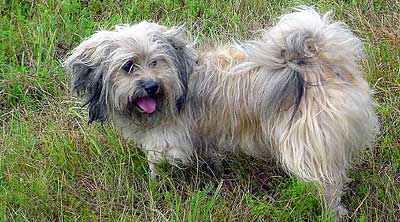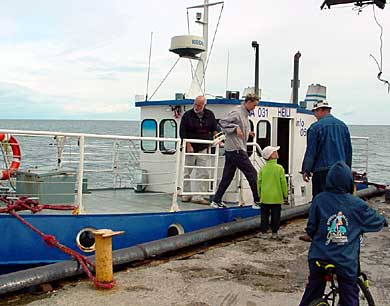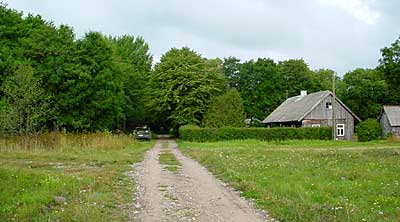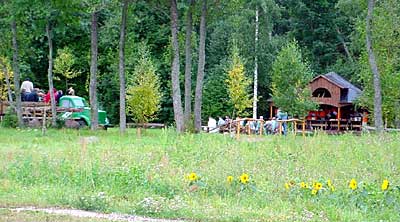Terrier Tour of Abruka Island, Estonia
Abby ran ahead of us on the dirt track, then looked back impatiently. She sat down on a grassy patch in between the shallow ruts made by the island's few cars. When we caught up, she barked a little, then escorted us on towards our next goal. Abby wasn't ours – just ours
for the day. Her choice.
In fact, our style of traveling doesn't usually bring us into contact with tour guides, but our  newfound friend – dubbed "Abby" after Abruka, the name of the island – was self-appointed, and unique. She turned up shortly after we arrived, and alternately followed and led us on our Abruka Island circumnavigation. When the population only totals fourteen, I guess it's not so surprising that the responsibility of tour guiding falls to a scruffy, grey terrier.
newfound friend – dubbed "Abby" after Abruka, the name of the island – was self-appointed, and unique. She turned up shortly after we arrived, and alternately followed and led us on our Abruka Island circumnavigation. When the population only totals fourteen, I guess it's not so surprising that the responsibility of tour guiding falls to a scruffy, grey terrier.
We'd managed to explore the rest of Estonia without a guide, even of the canine variety. Estonia was part of the USSR when we studied geography at school, so it wasn't a passport stamp I'd ever expected to collect. But the two weeks we spent wandering through this "new" nation, putting down our packs in each corner of the small country, were a revelation.
 What's Estonia like? Bits are old, but mostly well looked after or covered in scaffolding. Bits are new and pretty stylish. Locals are delightful and happy to chat in English. It's hard to find a Soviet influence, at least on the surface, even in the Russian border towns. Estonia has emerged from socialism more successfully than its Baltic sisters, Latvia and Lithuania, helped by its proximity to, and friendship with, Finland.
What's Estonia like? Bits are old, but mostly well looked after or covered in scaffolding. Bits are new and pretty stylish. Locals are delightful and happy to chat in English. It's hard to find a Soviet influence, at least on the surface, even in the Russian border towns. Estonia has emerged from socialism more successfully than its Baltic sisters, Latvia and Lithuania, helped by its proximity to, and friendship with, Finland.
Efficient Estonian Internet cafés helped us keep in contact with family back home. I'd mentioned our plans to visit a small island and my mother insisted on knowing its name so she could track our route in her USSR-era atlas. I didn't hold much hope of tiny Abruka rating a mention even in her thick book, but I tried to explain nonetheless. First, find the island of Saaremaa, in the southwestern part of Estonia, drifting where the Gulf of Finland meets the Baltic Sea. From Kuressaare, the main town on the island, look for a tiny dot which would be a thirty minute boat ride away. This is Abruka.
I probably couldn't get my mother to the right spot on her map, but Tõnnis the boatman got us over to Abruka without a hitch. A Saaremaa-born seaman who'd travelled the world working, Tõnnis had retired back to his home-island. He reminded me of my father somehow: a neat enough man who wouldn't be out of place in a tidy suit and tie, but who looks far more comfortable in the physical world, jumping nimbly from jetty to boat while hauling ropes off moorings and pointing out landmarks with sun-freckled hands. He chatted to us as he steered the 8:45 am boat across to Abruka, and was our up-to-the-minute source on population data. He should know since he's been ferrying the fourteen current islanders back and forth to the mainland for years now, and driving them when the sea freezes in the odd fierce winter.
a neat enough man who wouldn't be out of place in a tidy suit and tie, but who looks far more comfortable in the physical world, jumping nimbly from jetty to boat while hauling ropes off moorings and pointing out landmarks with sun-freckled hands. He chatted to us as he steered the 8:45 am boat across to Abruka, and was our up-to-the-minute source on population data. He should know since he's been ferrying the fourteen current islanders back and forth to the mainland for years now, and driving them when the sea freezes in the odd fierce winter.
After reaching the Abruka side of the sea, it was just a short walk from the jetty until the landscape struck me as not so different from parts of the bush back home in Australia, yet it was truly the other end of the world. The island is populated mostly in one small corner, and the rest is bushy forest, last felled over seventy years ago. A few narrow gravel tracks divide unfenced grassy areas, and occasionally a dirt path runs up to an old wooden house. Only some look lived in, and those have colourful flowers in garden beds, pots and even sprouting from an old pair of boots.

Friendly Abby led us along the island's various tracks. She stopped to greet anyone crossing our path, and the reactions showed if they were locals or visitors. She was obviously very well-known to the fourteen locals, or at least the six remaining at home today. We'd seen eight or so of them taking the 9:30 am boat over to Saaremaa for a Saturday shopping day. Amongst the trees and grass we found rundown shacks, barns full of straw, enough houses for the locals and a camping ground. We picnicked sitting on old tree trunks in a grassy area before a small dark-colored snake darted too close to us. From then on we cautiously stuck to the path and walked noisily, just as my father taught me to do in the Australian bush.
Abby's special circuit tour ended at the local swings. These were in fact our first Estonian swings, much anticipated after our guidebook described swinging as practically a national sport. We swayed on the wooden-seated swings, mounted at various heights, resting our feet for a while.
The house across from the swings had an unusual half-building next to it, and I didn't have to wait long to discover its special purpose. What appeared to be the island's bus – a large rusted green pick-up truck with two dozen people riding on open seats on the back – pulled up. The orange T-shirted members of the group formed an eight-person church choir, a Dutch group visiting for the day. The few remaining island locals joined the choir's “imported” supporters and a small congregation, plus the two of us perched on swings across the field, and enjoyed a brilliant burst of song from this purpose-built stage.

Without waiting for a tip, Abby ran off to her next appointment. The afternoon ferry run soon began, and we were reunited with Tõnnis on his ten-man boat.
"So, goodbye," he began, as he brought us into the Roomassaare port, "and I wish you good journey in our Estonia and healthy journey, and for your future and for ..." He trailed off, unable to find a good translation for his formal farewell. Instead, he shook our hands and gave us his business card.
We filed it away carefully, in case our travels ever take us back to far-flung Abruka.
